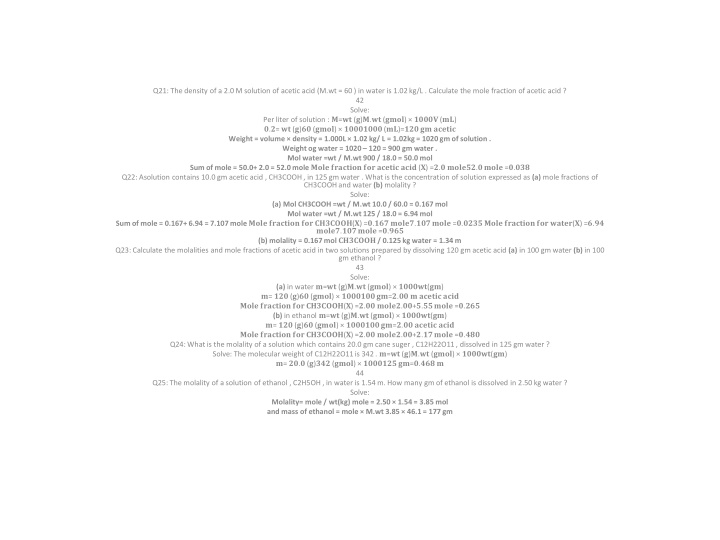
Chemistry Solutions and Concentrations Calculations
Learn how to calculate mole fractions, molality, and concentrations of solutions in chemistry through various examples. Understand the concepts of acid strength, electrolytes, and acid-base theories.
Uploaded on | 2 Views
Download Presentation

Please find below an Image/Link to download the presentation.
The content on the website is provided AS IS for your information and personal use only. It may not be sold, licensed, or shared on other websites without obtaining consent from the author. If you encounter any issues during the download, it is possible that the publisher has removed the file from their server.
You are allowed to download the files provided on this website for personal or commercial use, subject to the condition that they are used lawfully. All files are the property of their respective owners.
The content on the website is provided AS IS for your information and personal use only. It may not be sold, licensed, or shared on other websites without obtaining consent from the author.
E N D
Presentation Transcript
Q21: The density of a 2.0 M solution of acetic acid (M.wt = 60 ) in water is 1.02 kg/L . Calculate the mole fraction of acetic acid ? 42 Solve: Per liter of solution : ?=?? (?)?.?? (????) ?????(??) ?.?= ?? (?)?? (????) ????????(??)=????? ?????? Weight = volume density = 1.000L 1.02 kg/ L = 1.02kg = 1020 gm of solution . Weight ogwater = 1020 120 = 900 gm water . Mol water =wt / M.wt 900 / 18.0 = 50.0 mol Sum of mole = 50.0+ 2.0 = 52.0 mole ???? ???????? ????????? ???? (?) =?.? ??????.????? =?.??? Q22: Asolution contains 10.0 gm acetic acid , CH3COOH , in 125 gmwater . What is the concentration of solution expressed as (a) mole fractions of CH3COOH and water (b) molality ? Solve: (a) Mol CH3COOH =wt / M.wt10.0 / 60.0 = 0.167 mol Mol water =wt / M.wt 125 / 18.0 = 6.94 mol Sum of mole = 0.167+ 6.94 = 7.107 mole ???? ???????? ??????????(?) =?.????????.??????? =?.???????? ??????????? ?????(?) =?.?? ?????.??????? =?.??? (b) molality = 0.167 mol ???????/ 0.125 kg water = 1.34 m Q23: Calculate the molalities and mole fractions of acetic acid in two solutions prepared by dissolving 120 gm acetic acid (a) in 100 gm water (b) in 100 gm ethanol ? 43 Solve: (a) in water ?=?? (?)?.??(????) ??????(??) ?= ??? (?)??(????) ?????????=?.?? ? ?????? ???? ???? ???????? ??????????(?) =?.?? ?????.??+?.?????? =?.??? (b) in ethanol ?=?? (?)?.??(????) ??????(??) ?= ??? (?)??(????) ?????????=?.?? ?????? ???? ???? ???????? ??????????(?) =?.?? ?????.??+?.?????? =?.??? Q24: What is the molality of a solution which contains 20.0 gm cane suger , C12H22O11 , dissolved in 125 gm water ? Solve: The molecular weight of C12H22O11 is 342 . ?=?? (?)?.?? (????) ??????(??) ?= ??.?(?)??? (????) ?????????=?.???? 44 Q25: The molality of a solution of ethanol , C2H5OH , in water is 1.54 m. How many gm of ethanol is dissolved in 2.50 kg water ? Solve: Molality= mole / wt(kg) mole = 2.50 1.54 = 3.85 mol and mass of ethanol = mole M.wt3.85 46.1 = 177 gm
Q26: Calculate the molality of a solution containing (a) 0.65 mol glucose , C6H12O6 , in 250 gm water (b) 45 gm glucose in 1.00 kg water (c) 18 gm glucose in 200 gm water ? Solve: (a) Molality= mole / wt(kg) molality = 0.65/ 0.250 = 2.6 m (b) ?=?? (?)?.?? (????) ??????(??) ?= ?? (?)??? (????) ???????? ??=?.?? ? (c) ?=?? (?)?.?? (????) ??????(??) ?= ?? (?)??? (????) ??????? ??=?.?? ? Q27: How many gram CaCl2 should be added to 300 ml water to make up a 2.46 m solution ? Solve: Assuming that water has a density of 1.00 gm/ ml . Weight = density volume wt = 300 1.00 = 300 gm 45 ?=?? (?)?.?? (????) ??????(??) ?.??= ?? (?)??? (????) ??????? ??=??.? ??
Q28: Distinguish between acid strength and acid concentration ? Solve: The concentration of acid in a solution is determined by how many mol of acid is dissolved per L of solution ; its strength is determined by how completely it ionizes . Both of these factors affect the hydronium ion concentration . Q29: Explain why a solution containing a strong base and its salts does not act as a buffer solution ? Solve: Addition of OH- does not shift an equilibrium toward un-ionized base , as it would with a weak base and its conjugate . Q30: Explain the difference between a strong electrolyte and a weak electrolyte. Is an insoluble salt a weak or a strong electrolyte? Solve: A strong electrolyte is completely ionized in solution , while a weak electrolyte is only partially ionized in solution . Q31: What is the Br nsted acid base theory? What is the Lewis acid base theory? Solve: The bronsted acid- base theory assumes that an acid is a proton donor , and a base is a proton accepter . In the lewis theory , an acid is an electron accepter , while a base is an electron donor . Q32: Calculate the pH of a solution which has a hydronium ion concentration of 6 10-8 M ? Solve: PH = -log[H+] PH = - log 6 log 10-8 = -0.78 + 8= 7.22 46 Q33: Calculate the hydronium ion concentration of a solution which has a pH of 11.73 ? Solve: [ H+] = 10-PH [H+] = 10-11.73 = 100.27 10-12 From the logarithm table , 100.27 = 1.9 [H+] = 1.9 10-12 Q34: Calculate the hydrogen ion concentration and the hydroxide ion concentration in pure water at 25 0C ? Solve: 2H2O H3O+ + OH- Kw = [H+] [OH-] = 1.0 10-14 Let x = [H+] = [OH-] , hence x2 = 1.0 10-14 and x = 1.0 10-7M =[H+]= [OH-] Q35: Calculate the hydronium ion concentration of a 0.100 M NaOH solution ? Solve: NaOH Na+ + OH- 0.100M 0.100M Kw = [H+] [OH-] = 1.0 10-14 In this solution , 1.0 10-14 = [H+] (0.100) , thus [H+] = 1.0 10-13 M.
Q36: Calculate the PH values , assuming complete ionization , of (a) 4.9 10-4 M monoprotic acid (b) 0.0016 M monoprotic base ? Solve: (a) [H+] = 4.9 10-4 PH = -log [H+] = -log(4.9 10-4) = -log 4.9 + 4 = 3.31 (b) Kw = [H+] [OH-] = 1.0 10-14 [H+] = 10-14 / [OH-] [H+] = 10-14 / 1.6 10-3 PH = -log 10-14 / 1.6 10-3 = -(- 14- log 1.6 + 3) = 14 + 0.20 3 = 11.20 47 Q37: Calculate the PH of 1.0 10-3 M solutions of each the following: (a) HCl (b) NaOH (c) Ba(OH)2 (d) NaCl ? (a) PH = 3.00 (b) PH = 11.00 (c) PH = 11.30 (d) PH = 7 Q38: Calculate the pH and pOH of the following strong acid solutions: (a) 0.020 M HClO4, (b) 1.3 10 4 M HNO3, (c) 1.2 M HCl? Solve: (a) PH = - log [ H+ ] = - log 2 10-2 = 2 0.3 = 1.7 POH = 14 1.7 = 12.3 (b) PH = - log [ H+ ] = - log 1.3 10-4 = 4 0.11 = 3.89 POH = 14 3.89 = 10.11 (c) PH = - log [ H+ ] = - log 1.2 = - 0.08 POH = 14 (-0.08) = 14.08 Q39: Calculate the pH and pOH of the following strong base solutions: (a) 0.050 M NaOH, (b) 2.4 M NaOH,(c) 3.7 10 3 M KOH.? Solve: (a) POH = - log [ OH- ] = -log 5 10-2 = 2- 0.7 = 1.3 PH = 14 1.3 = 12.7 (b) POH = - log [ OH- ] = -log 2.4 = - 0.38 PH = 14 (-0.38) = 14.38 (c) POH = - log [ OH- ] = -log 3.7 10-3 = 3 0.57 = 2.43 PH = 14 2.43 = 11.57 Q40: Calculate the hydrogen ion concentration of the solutions with the following pH values: (a) 3.47, (b) 0.20, (c) 8.60 ? Solve: (a) [ H+ ] = 10-PH = 10-3.47 = 10-4 100.53 = 3.4 10-4 M . 48 (b) [ H+ ] = 10-PH = 10-0.02 = 10-1 100.80 = 6.3 10-1 M . (c) [ H+ ] = 10-PH = 10-8.6 = 10-9 100.40 = 2.5 10-9 M .
Q41: Calculate the pH and pOH of a solution obtained by mixing equal volumes of 0.10 M H2SO4 and 0.30 M NaOH ? Solve: Assume the volume = 1 ml Excess of NaOH = mmole of NaOH mmole of H2SO4 = 0.3 1 ml 0.1 1 ml 2 = 0.1 mmole of NaOH M = mmole / V(ml) = 0.1 / 2 ml = 0.5 M . POH = -log [ OH- ] = -log 5 10-2 = 2 0.7 = 1.3 PH = 14 1.3 = 12.70 42: Calculate the pH of a solution obtained by mixing equal volumes of a strong acid solution of pH 3.00 and a strong base solution of pH 12.00 ? Solve: Assume the volume = 1 ml [ H+ ] = 10-PH [ H+ ] of acid solution = 1.0 10-3 M . [ H+ ] of base solution = 1.0 10-12 M . [ H+ ] [ OH- ] = 1.0 10-14 1.0 10-12 [ OH- ] = 1.0 10-14 ; [ OH- ] = 1.0 10-14 / 1.0 10-12 = 1.0 10-2 M . Excess of base = mmole of NaOH mmole of acid = 1.0 10-2 * 1 ml 1.0 10-3 * 1 ml = 9 / 2 10-3 = 4.5 10-3 M . POH = -log [ OH- ] = -log 4.5 10-3 = 3 0.65 = 2.35 PH = 14 2.35 = 11.65






















